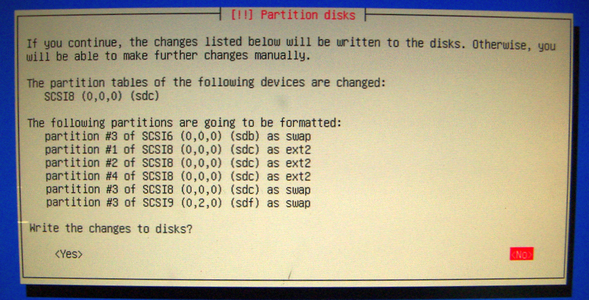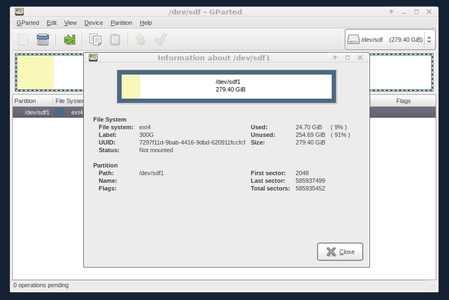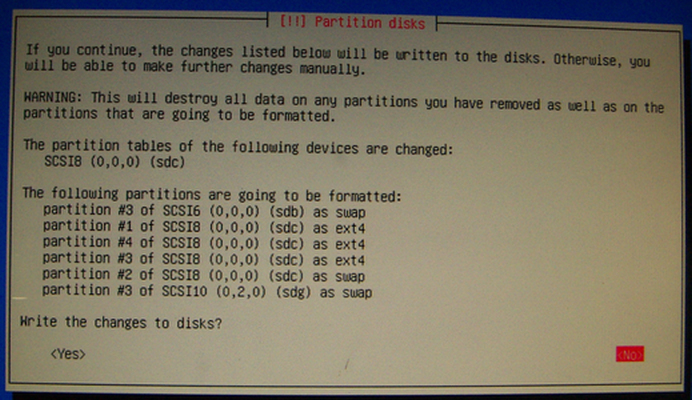You are not logged in.
- Topics: Active | Unanswered
Pages: 1
#1 2023-07-27 22:46:00
- Altoid
- Member
- Registered: 2017-05-07
- Posts: 1,949
Strange netinstall.iso behaviour
Hello:
I downloaded the devuan_chimaera_4.0.0_amd64_netinstall.iso, checked it aginst its SHA256SUM and burned it to a 64Gb USB2.0 stick.
The purpose was to install it to that same USB stick.
When I got to writing the partitions I came across something strange, see for yourselves:
The USB stick I am using for the installation is SCSI8 (sdc).
SCSI6 (sdb) is my system drive and /dev/sdb3 is the swap file.
SCSI9 (sdf) is *not* partitioned and it contains a few important backup files.
Anyone knows what is going on?
Thanks in advance.
Best,
A.
PD: sorry for the lousy image system but the one I had is no longer free.
Last edited by Altoid (2023-07-27 22:51:07)
Offline
#2 2023-07-28 01:04:30
- ralph.ronnquist
- Administrator
- From: Battery Point, Tasmania, AUS
- Registered: 2016-11-30
- Posts: 1,558
Re: Strange netinstall.iso behaviour
Have you done like that before? What did you expect to see?
Offline
#3 2023-07-28 01:59:42
- Altoid
- Member
- Registered: 2017-05-07
- Posts: 1,949
Re: Strange netinstall.iso behaviour
Hello:
Have you done like that before?
Install Linux directly on a USB drive?
Most probably, long ago.
Really can't recall.
What did you expect to see?
More like what I did not expect to see.
eg: the installer informing me that ...
- it would format partitions in drives that don't belong to the drive previously selected for the installation.
ie: drive selected is /dev/sdc but it informs that it will format partition #3 in /dev/sdb
- it would format an inexistent partition.
ie: drive /dev/sdf does not have a partition #3
Obviously, this problem has an easy enough solution: take all drives in my box off-line.
But questions remain:
Why does the installer want to work on drives not selected for the installation?
Why does the installer see an inexistent partition in one of those drives?
I think that that type of thing should not happen.
Surely it can't be because the selected drive is a USB stick?
Thanks in advance.
Best,
A.
Last edited by Altoid (2023-07-28 02:01:24)
Offline
#4 2023-07-28 02:44:52
- ralph.ronnquist
- Administrator
- From: Battery Point, Tasmania, AUS
- Registered: 2016-11-30
- Posts: 1,558
Re: Strange netinstall.iso behaviour
Looks funny yes, but it's hard to know what is happening when you start partitioning the installer disk, whose first partition (which spans the whole image) is mounted at that time.
Generally it's not a problem for the installer to install onto any other disk, whether USB or not, but installing over itself is probably stretching it too far.
If you for practical reasons or whatever really need the installed system to replace the installer on that USB, you need to exercise a fair bit of commandline fu to make that happen; e.g. by setting up an nbd disk image in RAM to install to, and then copy that onto the USB just before reboot... (not something I've done, but it could be fun ![]() )
)
... or maybe I have misunderstood your use case?
Offline
#5 2023-07-28 03:03:50
- Altoid
- Member
- Registered: 2017-05-07
- Posts: 1,949
Re: Strange netinstall.iso behaviour
Hello:
Looks funny yes ...
So I thought.
... hard to know what is happening when you start partitioning the installer disk ...
... installing over itself is probably stretching it too far.
Indeed.
For some reason I had it in my head/was convinced that is was loading to RAM ... 8^°
I wonder where I got that from?
... really need the installed system to replace the installer on that USB ...
No, not that at all.
More ignorance (of how the install process works) than anything else.
... misunderstood your use case?
You are too kind.
Thanks (many) for your input.
Best,
A.
Offline
#6 2023-07-28 08:32:05
- Camtaf
- Member
- Registered: 2019-11-19
- Posts: 506
Re: Strange netinstall.iso behaviour
I've not used a net install, so can't say, but, I usually use one pendrive for the install media, & a separate pendrive to install it to, just like I do when installing to internal disks. ![]()
Could it be the fact that you are trying to install it to the same pendrive as you are booting from(?), I've never tried to do that.
Offline
#7 2023-07-28 10:03:31
- Altoid
- Member
- Registered: 2017-05-07
- Posts: 1,949
Re: Strange netinstall.iso behaviour
Hello:
... you are trying to install it to the same pendrive ...
Exactly.
See previous posts.
Thanks for your input.
Best,
A.
Offline
#8 2023-07-28 11:03:57
- fsmithred
- Administrator

- Registered: 2016-11-25
- Posts: 2,787
Re: Strange netinstall.iso behaviour
For some reason I had it in my head/was convinced that is was loading to RAM ... 8^°
I wonder where I got that from?
Live isos can boot the entire iso into RAM. That's an option in live-boot that isn't available in the installer isos. Add "toram" or maybe "toram=filesystem.squashfs" to the boot command for a live-usb and then it's not running from the usb stick. You could even remove the usb stick and keep running the system. Booting that way might allow you to install over the imaged usb, but then you have to get it right the first time or else start over with imaging the stick.
Offline
#9 2023-07-28 11:29:23
- Altoid
- Member
- Registered: 2017-05-07
- Posts: 1,949
Re: Strange netinstall.iso behaviour
Hello fsr:
Live isos can boot the entire iso into RAM.
Yes.
Add "toram" or maybe "toram=filesystem.squashfs" to the boot command for a live-usb ...
... that way might allow you to install over the imaged usb, but then you have to get it right the first time ...
That's a good idea.
Have to get it right the first time around.
Thanks for your input.
Best,
A.
Offline
#10 2023-07-28 11:52:06
- Altoid
- Member
- Registered: 2017-05-07
- Posts: 1,949
Re: Strange netinstall.iso behaviour
Hello:
Having come to my senses, I went ahead and did it right way. 8^°
I burned the netinstall.iso to a 2.0Gb MicroSD card to install to the previously used 64Gb USB2.0 stick.
During the installation I chose to delete everything on the stick so it would start anew.
But I got the same behaviour from the installer:
eg: the installer informing me that ...
- it would format partitions in drives that don't belong to the drive previously selected for the installation.
ie: drive selected is /dev/sdc but it informs that it will format partition #3 in /dev/sdb- it would format an inexistent partition.
ie: drive /dev/sdf does not have a partition #3
Any idea as to what is happening?
Why would the installer want to muck around with a drive not selcted for installation?
Thanks in advance.
Best,
A.
Offline
#11 2023-07-28 13:22:10
- ralph.ronnquist
- Administrator
- From: Battery Point, Tasmania, AUS
- Registered: 2016-11-30
- Posts: 1,558
Re: Strange netinstall.iso behaviour
How does the dialog before that one look?
Offline
#12 2023-07-28 14:00:34
- Camtaf
- Member
- Registered: 2019-11-19
- Posts: 506
Re: Strange netinstall.iso behaviour
Partition your disk manually, seems to be an option, so I'd take a look at that.
Offline
#13 2023-07-28 14:10:41
- Altoid
- Member
- Registered: 2017-05-07
- Posts: 1,949
Re: Strange netinstall.iso behaviour
Hello:
Partition your disk manually ...
That is exactly what I am doing.
Thanks for your input.
Best,
A.
Offline
#14 2023-07-28 14:41:52
- fsmithred
- Administrator

- Registered: 2016-11-25
- Posts: 2,787
Re: Strange netinstall.iso behaviour
I've seen the disk order change when booting with usb in some cases such that what was /dev/sda when booting from internal drive is called some other device name in the installer.
Offline
#15 2023-07-28 15:34:52
- Altoid
- Member
- Registered: 2017-05-07
- Posts: 1,949
Re: Strange netinstall.iso behaviour
Offline
#16 2023-07-28 15:39:39
- Altoid
- Member
- Registered: 2017-05-07
- Posts: 1,949
Re: Strange netinstall.iso behaviour
Hello fsr:
... seen the disk order change when booting with usb ...
Yes, I think that happens always.
But it does not matter here as the installation drive is easy to identify.
Unless I am not paying attention, the right drive will be formatted and receive the installation.
The problem (as I see it) is that the installer wants to muck around with other drives and in ways that don't make sense.
eg: formatting an inexistent partition. (?)
Thanks for your input.
Best,
A.
Offline
#17 2023-07-28 23:39:25
- ralph.ronnquist
- Administrator
- From: Battery Point, Tasmania, AUS
- Registered: 2016-11-30
- Posts: 1,558
Re: Strange netinstall.iso behaviour
Ok. Apparently the partitioner picks up all swap partitions (can't see sdg3 but taht'd be another swap partition). It should be possible to avoid that by deslecting those ("don't use this partition") via that previous dialog.
Offline
#18 2023-07-29 09:43:56
- Camtaf
- Member
- Registered: 2019-11-19
- Posts: 506
Re: Strange netinstall.iso behaviour
As I said earlier, if he selects manual partitioning he should be able to do that; or change the whole layout completely. ![]()
Offline
#19 2023-07-29 14:00:41
- Altoid
- Member
- Registered: 2017-05-07
- Posts: 1,949
Re: Strange netinstall.iso behaviour
Hello:
Apparently the partitioner picks up all swap partitions ...
Apparently so, would have to delve further into that.
But ...
Remember my first post: the installer wanted to format a partiton that did not exist.
Now, having 1) chosen to do an expert install, 2) selected specific drive to use and 3) having opted to partition it manually, I think that this should not be happening.
I did what you suggested and made sure that "don't use this partition" was used on every partition I could find that did not belong to the drive I selected for the installation and that worked.
As the other ie: /, /var and /home partitions were already established, the installer only formatted the /swap partition.
That said, why isn't every partition set up as "don't use this partition" by default?
Why does the installer pick up a /swap partition from a previously unselected drive?
I don't understand what is going on, maybe a glitch or a bug? Quite worrisome, at least to me.
In any case, I stopped the installation at 32% as it had been there for well over 15'.
I guess that installing on a 64GB USB2.0 will do that and as the damn things no longer come with the luxury of an activity LED, you really don't know if it is being written to or the install process went awry for whatever reason.
I'll try again this weekend.
Thanks for your input.
Best,
A.
Offline
#20 2023-07-29 22:48:15
- GlennW
- Member

- From: Brisbane, Australia
- Registered: 2019-07-18
- Posts: 688
Re: Strange netinstall.iso behaviour
It takes a few minutes to go through that part of the install session, and fstab (my files) will be ready ready for access.
I remember with one of the installers I used (ascii ?) you could cut and paste the directories.
It comes out Like this,
/etc/fstab
# /etc/fstab: static file system information.
#
# Use 'blkid' to print the universally unique identifier for a
# device; this may be used with UUID= as a more robust way to name devices
# that works even if disks are added and removed. See fstab(5).
#
# systemd generates mount units based on this file, see systemd.mount(5).
# Please run 'systemctl daemon-reload' after making changes here.
#
# <file system> <mount point> <type> <options> <dump> <pass>
# / was on /dev/sdc2 during installation
UUID=2f62f5a2-14f6-405d-8849-9fa7e3210d08 / ext4 errors=remount-ro 0 1
# /home was on /dev/sdc7 during installation
UUID=0bd195fc-4031-4b5c-a4c9-c807a749c60e /home ext4 defaults 0 2
# /tmp was on /dev/sdc5 during installation
UUID=f6c50808-b2c7-4ece-8d5a-52e1fc520771 /tmp ext4 defaults 0 2
# /usr/src was on /dev/sdc6 during installation
UUID=56eb9205-18e7-43b7-89dd-60f55a8c60cc /usr/src ext4 defaults 0 2
# /var was on /dev/sdc3 during installation
UUID=ab8dfd96-4930-42d8-b07a-3212ab1bc60d /var ext4 defaults 0 2
# swap was on /dev/sdc4 during installation
UUID=f0eccce4-0bf9-4238-a477-c13d46a0814d none swap sw 0 0
# swap was on /dev/sdd3 during installation
UUID=e1d942bf-0f66-4294-980f-293c3815ef31 none swap sw 0 0
# /home/glenn/local/archive was on /dev/sdb6 during installation
UUID=e5747e43-525b-4311-b53b-f66fc7b81809 /home/glenn/local/archive ext4 defaults 0 2
# /home/glenn/local/data was on /dev/sdb2 during installation
UUID=4a130c74-c9a0-4369-af07-3f6954939073 /home/glenn/local/data ext4 defaults 0 2
# /home/glenn/local/free was on /dev/sdb5 during installation
UUID=7c682119-06c5-4f9d-bdc2-a7c6bbddb2f7 /home/glenn/local/free ext4 defaults 0 2
# /home/glenn/local/media/circus was on /dev/sdb7 during installation
UUID=913582e9-3f2d-40f6-8494-7136a81db07d /home/glenn/local/media/circus ext4 defaults 0 2
# /home/glenn/local/media/movies was on /dev/sdb9 during installation
UUID=d02d15fb-b266-4fe1-bc49-d341b1984610 /home/glenn/local/media/movies ext4 defaults 0 2
# /home/glenn/local/media/music was on /dev/sdb8 during installation
UUID=bf2c2b46-6cb1-4677-b613-b6763be457ea /home/glenn/local/media/music ext4 defaults 0 2
# /home/glenn/local/other was on /dev/sdb1 during installation
UUID=fcf78297-e13b-4b96-9acf-8f6a5465a3eb /home/glenn/local/other ext4 defaults 0 2
# /home/glenn/local/spare was on /dev/sdb3 during installation
UUID=d2a98357-069d-420c-9722-904268da1538 /home/glenn/local/spare ext4 defaults 0 2
# mount install.iso as a directory
# /mnt/storage/debian-8.2.0-i386-CD-1.iso /mnt/debian-cd/ udf,iso9660 loop 0 0
/home/glenn/My_system/system-isos/devuan/devuan_daedalus_5.0.preview-20230601_amd64_desktop.iso /home/glenn/local/archive/debs/iso/devuan_daedalus_5.0.preview-20230601_amd64_desktop udf,iso9660 loop 0 0
/home/glenn/My_system/system-isos/devuan/devuan_daedalus_5.0.preview-20230601_i386_desktop.iso /home/glenn/local/archive/debs/iso/devuan_daedalus_5.0.preview-20230601_i386_desktop udf,iso9660 loop 0 0
# DVD burner.
/dev/sr0 /media/cdrom0 iso9660 ro,user,auto 0 0a pet hate on a (brand) new SSD drive the installer auto matically selects "dos mbr" .
So I did the partitioning before the installation with a live devuan session.
I prefer GPT and using UUIDs. My drives change order all the time, UUIDs help.
Next... every time you format a partition it get a new UUID. So you should get one for that "swap" that was reformatted.
It adds a quite a bit of time to the install (and sometimes wont start) if I don't format / and /var.
This is a single user PC.
I used to have more separate system partitions, /usr /boot /usr/src /var /home
all the best.
pic from 1993, new guitar day.
Offline
#21 2023-07-30 12:11:54
- Altoid
- Member
- Registered: 2017-05-07
- Posts: 1,949
Re: Strange netinstall.iso behaviour
Hello:
... comes out Like this,
--- snip ---
... did the partitioning before the installation ...
Yes, I used to do it like that.
Every time I moved from one distribution to the next one in line.
I then settled on Devuan ~6 years ago.
I was very much used to /dev/sdx notation but eventually started using UUIDs.
... every time you format a partition it get a new UUID.
Indeed ...
And your fstab gets ... fstabbed.
Resulting in a warning about the system not finding a UUID, usually happens when you resize the /swap partition.
... used to have more separate system partitions ...
The benefit of separate partitions for /home, /var and /swap are important.
I also use primary partitions, easier/faster to work with than primary+extended if you don't need more than four partitions.
My box has 8.0GB RAM and the 4.0GB swap partition (in my case) practically gets no use as I have priority set to -2 (it is a small SSD).
Should I need more disk space I will see about a tmpfs for swap, have been puting it off for the longest time.
With respect to the reason for this thread, I think the installer is not working properly.
ie:
Once a specific drive is selected for the installation, the default behaviour should be that no partition on any other drive be used for anything.
More yet, the installer should warn that a partition outside the selected installation drive will be used before continuing with the process.
Thanks for your input.
Best,
A.
Offline
#22 2023-07-30 20:52:08
- GlennW
- Member

- From: Brisbane, Australia
- Registered: 2019-07-18
- Posts: 688
Re: Strange netinstall.iso behaviour
The installer has been picking up swap files from any attached drive. since I remember, but also other distros I have used.
When I had windows I put the swap on a separate HDD and really noticed (benchmark-able) a speed increase.
That's all I got for now. Devuan is good.
(the second swap on my system is from a ubuntu-studio install that I'm playing with)
Thank you
Last edited by GlennW (2023-07-30 21:02:23)
pic from 1993, new guitar day.
Offline
#23 2023-07-30 23:31:26
- Altoid
- Member
- Registered: 2017-05-07
- Posts: 1,949
Re: Strange netinstall.iso behaviour
Hello:
... installer has been picking up swap files from any ...
I don't think that should happen.
You have seen it in other (Debian based?) distributions because the installer code is common to all of them.
... put the swap on a separate HDD and really noticed ...
Yes, I also did that (another life, many years ago) when I could get my hand on another HDD.
When memory prices dropped, things changed a bit.
Thanks for your input.
Best,
A.
Offline
Pages: 1





